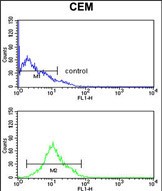KCNJ11 Antibody (N-term)
Affinity Purified Rabbit Polyclonal Antibody (Pab)
- SPECIFICATION
- CITATIONS
- PROTOCOLS
- BACKGROUND

Application
| FC, WB, E |
|---|---|
| Primary Accession | Q14654 |
| Other Accession | O02822, Q61743 |
| Reactivity | Human, Mouse |
| Predicted | Rabbit |
| Host | Rabbit |
| Clonality | Polyclonal |
| Isotype | Rabbit IgG |
| Calculated MW | 43526 Da |
| Antigen Region | 1-30 aa |
| Gene ID | 3767 |
|---|---|
| Other Names | ATP-sensitive inward rectifier potassium channel 11, IKATP, Inward rectifier K(+) channel Kir62, Potassium channel, inwardly rectifying subfamily J member 11, KCNJ11 |
| Target/Specificity | This KCNJ11 antibody is generated from rabbits immunized with a KLH conjugated synthetic peptide between 1-30 amino acids from the N-terminal region of human KCNJ11. |
| Dilution | FC~~1:10~50 WB~~1:1000 E~~Use at an assay dependent concentration. |
| Format | Purified polyclonal antibody supplied in PBS with 0.09% (W/V) sodium azide. This antibody is purified through a protein A column, followed by peptide affinity purification. |
| Storage | Maintain refrigerated at 2-8°C for up to 2 weeks. For long term storage store at -20°C in small aliquots to prevent freeze-thaw cycles. |
| Precautions | KCNJ11 Antibody (N-term) is for research use only and not for use in diagnostic or therapeutic procedures. |
| Name | KCNJ11 |
|---|---|
| Function | Inward rectifier potassium channel that forms the pore of ATP-sensitive potassium channels (KATP), regulating potassium permeability as a function of cytoplasmic ATP and ADP concentrations in many different cells (PubMed:29286281, PubMed:34815345). Inward rectifier potassium channels are characterized by a greater tendency to allow potassium to flow into the cell rather than out of it. Their voltage dependence is regulated by the concentration of extracellular potassium; as external potassium is raised, the voltage range of the channel opening shifts to more positive voltages. The inward rectification is mainly due to the blockage of outward current by internal magnesium. Can be blocked by extracellular barium (By similarity). In pancreatic cells, it forms KATP channels with ABCC8/SUR1 (PubMed:29286281, PubMed:34815345). Can form cardiac and smooth muscle-type KATP channels with ABCC9. |
| Cellular Location | Membrane; Multi-pass membrane protein. |

Thousands of laboratories across the world have published research that depended on the performance of antibodies from Abcepta to advance their research. Check out links to articles that cite our products in major peer-reviewed journals, organized by research category.
info@abcepta.com, and receive a free "I Love Antibodies" mug.
Provided below are standard protocols that you may find useful for product applications.
Background
ATP-sensitive potassium (K(ATP)) channels are found in endocrine cells, neurons and both smooth and striated muscle, where they play an important role in controlling insulin secretion and vascular tone, and protect neurons under metabolic stress. Kir6.2 is a member of the inward rectifier potassium channel family, which is characterised by a greater tendency to allow potassium flow into the cell rather than out of it. It associates with the sulphonylurea receptor SUR1/ABCC8 to form a subfamily of K(ATP) channels that, when mutated or misregulated, are associated with forms of hyperinsulinemic hypoglycemia, neonatal diabetes, or pre-disposition to type 2 diabetes mellitus.
If you have used an Abcepta product and would like to share how it has performed, please click on the "Submit Review" button and provide the requested information. Our staff will examine and post your review and contact you if needed.
If you have any additional inquiries please email technical services at tech@abcepta.com.













 Foundational characteristics of cancer include proliferation, angiogenesis, migration, evasion of apoptosis, and cellular immortality. Find key markers for these cellular processes and antibodies to detect them.
Foundational characteristics of cancer include proliferation, angiogenesis, migration, evasion of apoptosis, and cellular immortality. Find key markers for these cellular processes and antibodies to detect them. The SUMOplot™ Analysis Program predicts and scores sumoylation sites in your protein. SUMOylation is a post-translational modification involved in various cellular processes, such as nuclear-cytosolic transport, transcriptional regulation, apoptosis, protein stability, response to stress, and progression through the cell cycle.
The SUMOplot™ Analysis Program predicts and scores sumoylation sites in your protein. SUMOylation is a post-translational modification involved in various cellular processes, such as nuclear-cytosolic transport, transcriptional regulation, apoptosis, protein stability, response to stress, and progression through the cell cycle. The Autophagy Receptor Motif Plotter predicts and scores autophagy receptor binding sites in your protein. Identifying proteins connected to this pathway is critical to understanding the role of autophagy in physiological as well as pathological processes such as development, differentiation, neurodegenerative diseases, stress, infection, and cancer.
The Autophagy Receptor Motif Plotter predicts and scores autophagy receptor binding sites in your protein. Identifying proteins connected to this pathway is critical to understanding the role of autophagy in physiological as well as pathological processes such as development, differentiation, neurodegenerative diseases, stress, infection, and cancer.



